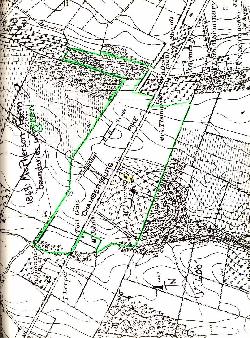
John T. Slentz was in this case the willing applicant, and moved in with his wife Eliza, two school-age daughters, Mary G. and Ida B., and infant Sarah.39 More children, at least two sons (Charles J. and R--)
were born subsequent to 1860. Little Sarah reminisced about seventy years later relative to the appearance
of the McPherson farmhouse where she grew up. She described the farmhouse as being of log and stone
(indicative of the 1798 material, and verified by the 1863 Brady photograph), and the back part of the house
(that closest to Reynolds Woods) was of log. The front part, or that part closest to the Cashtown Pike, was
of stone. She enumerated the plan of the house as follows:
19
1. In the back part downstairs (built of logs) were a kitchen and dining room.
2. In the front part downstairs (built of stone) were a bedroom and a living room or parlor.
3. On the second floor of the back log section were two bedrooms.
4. On the second floor of the front stone section were another two bedrooms.
According to Sarah Slentz, when you traversed the building from the back to the front (i.e., the log to the stone), you had to make a two-step elevation both upstairs and downstairs. 40 She provided no information about the barn or other outbuildings, since the interview was primarily concerned with the appearance of the house, and the interviewers asked no recorded questions about the existing bank barn.
The routine of the growing family was unbroken, even after the Civil War broke out. McPherson
was away in Washington, pressed with the legislative urgencies and duties of a war-time Congress, so Slentz
was not much bothered with landlord troubles. While the war raged in other states, the Pennsylvania farmer
was untouched, and John Slentz steadily built up his livestock and crop resources. By July of 1863, he was
of above average wealth, as far as personal estate goes, compared to the farmers south of town, and fairly
successful as far as tenant farmers go. He had managed to accumulate enough capital so that
21
by 1863's planting time he had three cows and six calves, four horses, four hogs, three turkeys, and at least
forty chickens.41 Over half of the 95 acres was planted in crops--wheat, corn, oats, and grass. The
remainder, about thirty acres, was in woodland and pasture for the stock and a young orchard for home
preserving and cooking use.
Within the house were the pride-and-joy possessions of a family growing in affluence. These included a ten-plate stove, beds with bed curtains, a parasol, carpeting, and silk dresses, as well as the necessities and inevitables--the family Bible, kitchenwares, pillows and bolsters, and crude furniture. Everything was looking bright for John Slentz in June of 1863, until the events of June 30 brought the circumstances of the first real "national" war to his front yard.

40 J. Melchior Sheads & J. Roger Dunn, "Historian's Report: Old McPherson Farm House", (GNMP
files, McPherson Farm, no date).
Return to Text
41 Claims file, John T. Slentz.
Return to Text